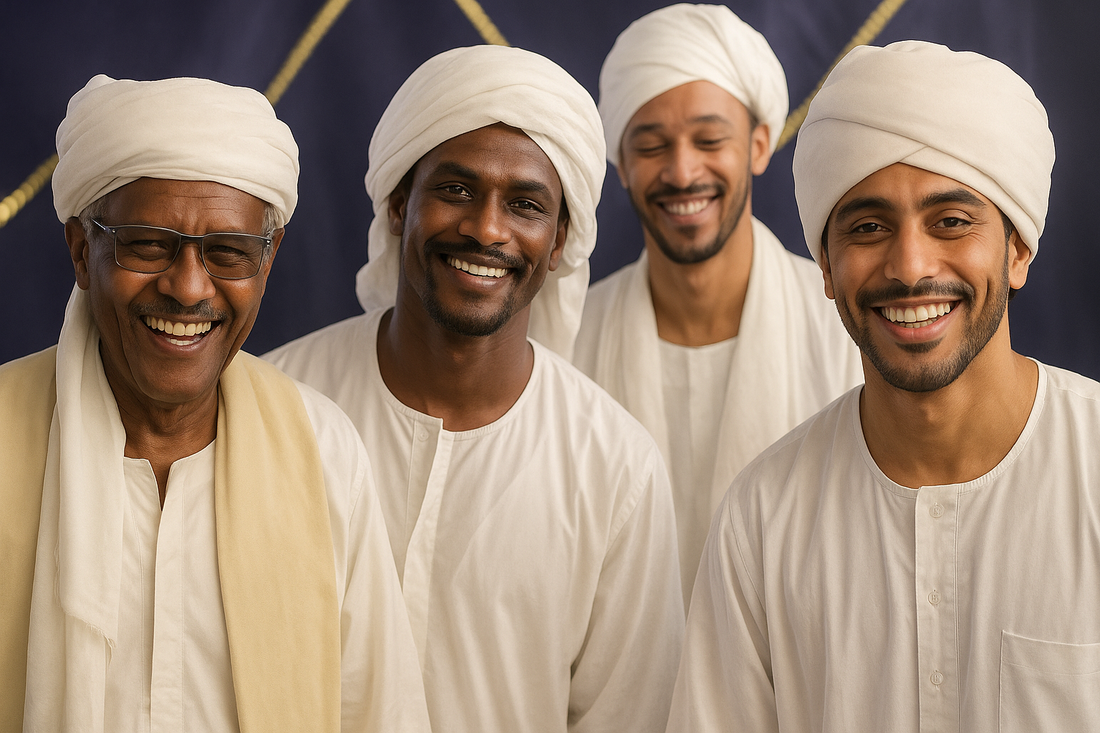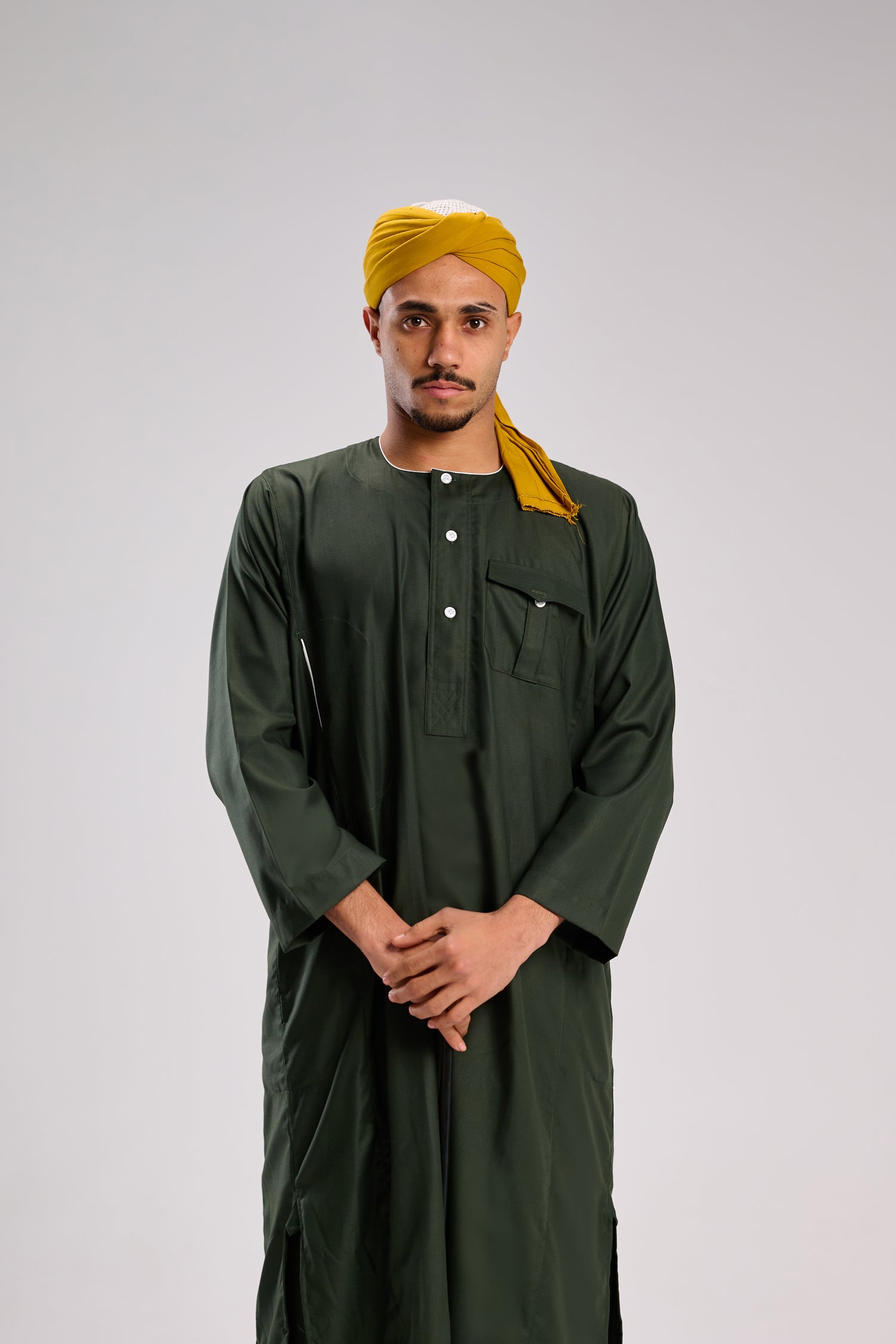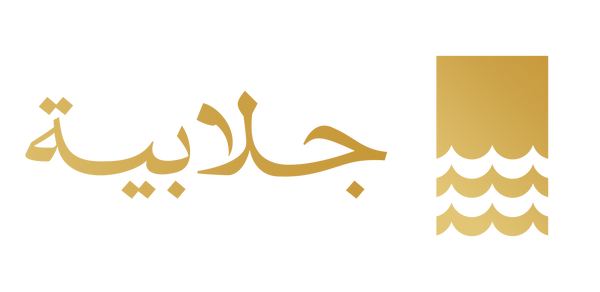
The Sudanese Turban: Between Authenticity and Innovation
Share
The Sudanese turban: an identity that is incomplete without it
The Sudanese turban is one of the most prominent symbols of cultural identity in Sudan, as traditional Sudanese dress is incomplete without it. Wearing a turban expresses dignity and is a men's accessory, especially for formal occasions such as weddings and celebrations. It is also used for practical purposes, such as protection from the heat of the sun and dust in desert areas, reflecting its connection to the daily lives of Sudanese people, particularly in rural areas.
spiritual and cultural symbolism 
The turban is more than just a piece of cloth; it carries deep spiritual and cultural symbolism. In some popular interpretations, the turban is viewed as a shroud worn by ascetics and Sufis, symbolizing their renunciation of the world and their constant readiness to depart from it. This concept enhances its sanctity and status among certain segments of society, who view it as an expression of humility and spiritual elevation.
Types of Sudanese turbans
The Sudanese turban: a set with a shawl and complete elegance 
One of the most prominent manifestations of Sudanese men's elegance is the wearing of the turban as part of a complete outfit that includes a white or colored jalabiya, along with a shawl thrown over the shoulder or wrapped around the neck. This outfit, known for its meticulous coordination and dignified appearance, is used for formal occasions such as weddings, holidays, and national celebrations, and reflects the Sudanese people's dedication to elegance in their appearance. In this context, the shawl is not merely an accessory; it adds aesthetic and symbolic value that complements the turban. Shawl fabrics vary between wool and cotton, and are often embroidered with fine threads to showcase the luxurious design.
The Ansariya Turban: A Symbol of Religious Belonging and Spiritual Identity
The Ansariya turban is one of the most popular types of turbans in Sudan, historically associated with the Ansar, a religious and social group with deep roots in Sudanese history. Those who wear the Ansariya turban are distinguished by their specific wrapping method, making it a clear symbol of intellectual and religious affiliation. This turban is not only used for adornment; it also reflects a commitment and intellectual stance, which is why it is prominently present at major religious occasions such as the celebrations of the Prophet's birthday or the anniversary of the Imam Mahdi. The Ansariya turban is a living example of how clothing can become a means of expressing belief and identity.
Colorful Youth Sciences : Renewing the Look with the Spirit of the Times 
With changing lifestyles and the influx of fashion into everyday life, a new style of Sudanese turbans has emerged, targeting young people in particular. These turbans come in bold and bright colors, such as royal blue, olive green, maroon, and even pink and purple, and are wrapped in unconventional ways that showcase a modern and daring character. No longer reserved for sheikhs or formal occasions, the turban is now worn for gatherings with friends, trips, and photoshoots, and has even become part of Sudanese street style. Some young people combine the turban with jeans or casual clothes, in a unique blend of tradition and modernity. This phenomenon reflects young people's desire to preserve their heritage, but in a way that expresses their own identity.
Luxury Swiss turbans with hand embroidery: unique luxury and elegance 
In the world of luxury turbans, Swiss turbans stand out as the choice of the elite and those with a keen eye for detail. Made from soft, high-quality cotton imported from Switzerland, some turbans are hand-embroidered with silver or gold threads along the edges, giving them a touch of sophistication and exclusivity. These turbans are the most expensive and most commonly used for high-profile events such as weddings or public gatherings. They are chosen by men who seek to appear elegant and unique, combining high quality with refined taste. With the development of the Sudanese market and the diversification of suppliers, these turbans have become available to a wider segment of the population, contributing to a rise in public taste in turban selection.
Kamal Tarbas's aunt: a special way of expression ![Kamal Tarbas – Madad Basthem – Cassette (Album, Stereo), [r32083575] | Discogs](https://i.discogs.com/_bSBoj8Thp7scVh4YtaLsxcgdkAhVBgL5cwGjFxgcsA/rs:fit/g:sm/q:90/h:600/w:391/czM6Ly9kaXNjb2dz/LWRhdGFiYXNlLWlt/YWdlcy9SLTMyMDgz/NTc1LTE3Mjk5MjQ2/MDQtMjczMC5qcGVn.jpeg)
One of the most prominent Sudanese figures known for his distinctive turban-wearing style is artist Kamal Tarbas, whose name is synonymous with his oversized turban, to the point that it has become an integral part of his artistic and personal identity. His turban was not merely a head covering, but rather a means of expressing uniqueness and pride in Sudanese heritage, forming a striking visual element in all his appearances. For Tarbas, the size of his turban reflects a sense of pride and a likable exaggeration that adds a beloved humorous touch to his artistic personality, making it a distinctive mark in the public's memory.
Traditional turban vs. youth turban 
When comparing the traditional turban with the modern youth turban, we notice that the traditional turban emphasizes dignity and simplicity, while the youth turban favors bold colors and patterns, reflecting a trend toward personal expression and distinction. Despite these differences, the cultural connection remains strong, as everyone agrees that the turban, in its various forms, remains an authentic Sudanese symbol and an indispensable heritage.
In addition to the difference in the way of wrapping, the traditional turban is wrapped in a less orderly manner than the youth turban, while the youth turban tends to have a more orderly shape with the turban fabric applied in clear and defined layers.
The youth turban has received a lot of criticism, as it may be closer to other cultures such as India, and its size is smaller compared to the well-known Sudanese turban.
What do you prefer?





1 comment
التقليدية طبعا قماشها زاتو مختلف وبيدي فخامة